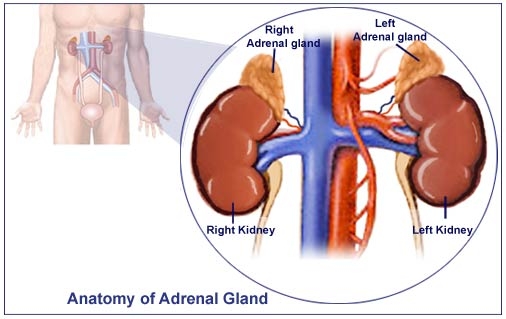 |
Addison's disease (also known as chronic adrenal insufficiency, or hypocortisolism) is a rare endocrine disorder, first described by British physician Thomas Addison. It is estimated that it affects about 1 to 2 in 100,000 people. It occurs when the adrenal glands, seated above the kidneys, fail to produce enough of the hormone cortisol and, sometimes, the hormone aldosterone. Addison's disease refers specifically to primary adrenal insufficiency, in which the adrenal glands themselves malfunction; secondary adrenal insufficiency occurs when the pituitary gland does not produce enough adrenocorticotropic hormone (ACTH) to adequately stimulate the adrenal glands. A famous sufferer of Addison's Disease was President John F. Kennedy. Jane Austen is thought to have been another.
The condition is very common in dogs, particularly the Bearded Collie and Chihuahua. In dogs it is inherited via the female line - possibly due to autoimmune antibodies in the milk.
Addison's disease progresses slowly, and symptoms may not present or be noticed until some stressful illness or situation occurs. Common symptoms are:
chronic fatigue that gradually worsens
muscle weakness
loss of appetite
weight loss
nausea/vomiting
diarrhea
low blood pressure that falls further when standing (orthostatic hypotension)
areas of hyperpigmentation (darkened skin), known as melasma suprarenale.
irritability
depression
craving for salt and salty foods
hypoglycaemia (worse in children)
for women, menstrual periods that become irregular or cease
tetany (particularly after drinking milk) due to phosphate excess
numbness of the extremities, sometimes with paralysis, due to potassium excess
An illness or accident can aggravate the adrenal problems and cause an Addisonian crisis in which the symptoms include:
brown coating on tongue and teeth due to iron loss hemolysis
sudden penetrating pain in the legs, lower back or abdomen
severe vomiting and diarrhea, resulting in dehydration
low blood pressure
loss of consciousness
hypoglycemia
|
|
Untreated, an Addisonian crisis can be fatal. It is a medical emergency.
In suspected cases of Addison's disease, one needs to demonstrate that adrenal hormone levels are low after appropriate stimulation with synthetic pituitary hormone. Once demonstrated, the cause of adrenal failure needs to be elucidated. The most common cause is autoimmune, and can be tested for with an assay for 21-hydroxylase antibodies. If there are no antibodies present, infectious or genetic causes should be sought. This may include imaging of the adrenal glands, tests for tuberculosis or HIV infection, and searching for metastatic cancer.
Eighty to ninety percent of cases of Addison's disease are said to be due to autoantibodies directed against adrenal cells containing 21-hydroxylase, an enzyme involved in the production of cortisol and aldosterone. The remainder of cases are due to tuberculosis, HIV, sarcoidosis, amyloidosis, hemochromatosis, metastatic cancer to the adrenal glands, adrenal haemorrhage and congenital adrenal hyperplasia. Addison's disease can be an expression of an autoimmune polyendocrine syndrome when autoimmune reactions against other organs are also present. In APS type 1, 70% suffer from Addison's disease, while in type 2, 100% do. Through these syndromes, Addison's is associated with hypothyroidism, diabetes mellitus (type 1),vitiligo, alopecia and celiac disease.
Treatment for Addison's disease involves replacing the missing cortisol and, if necessary, providing replacement therapy for the missing aldosterone. Caution must be exercised when the person with Addison's disease has surgery or becomes pregnant.
|
|
|